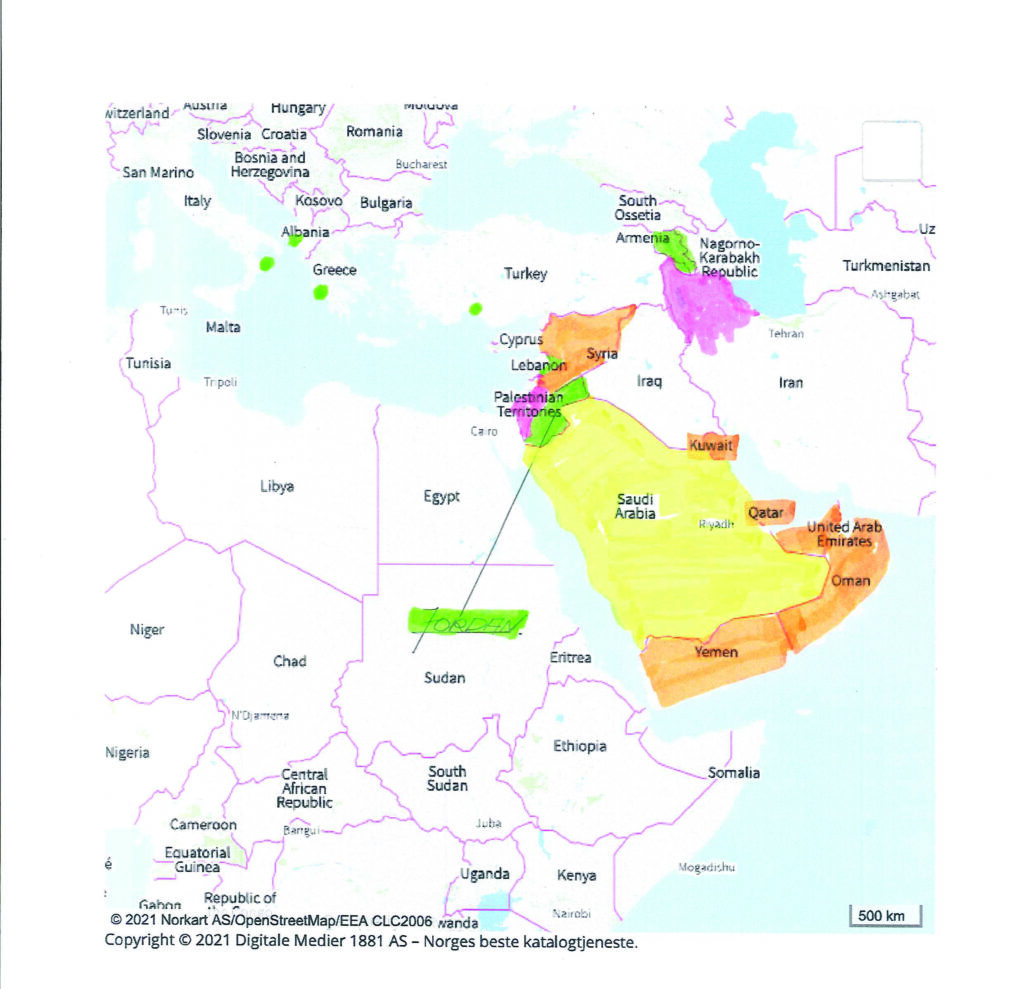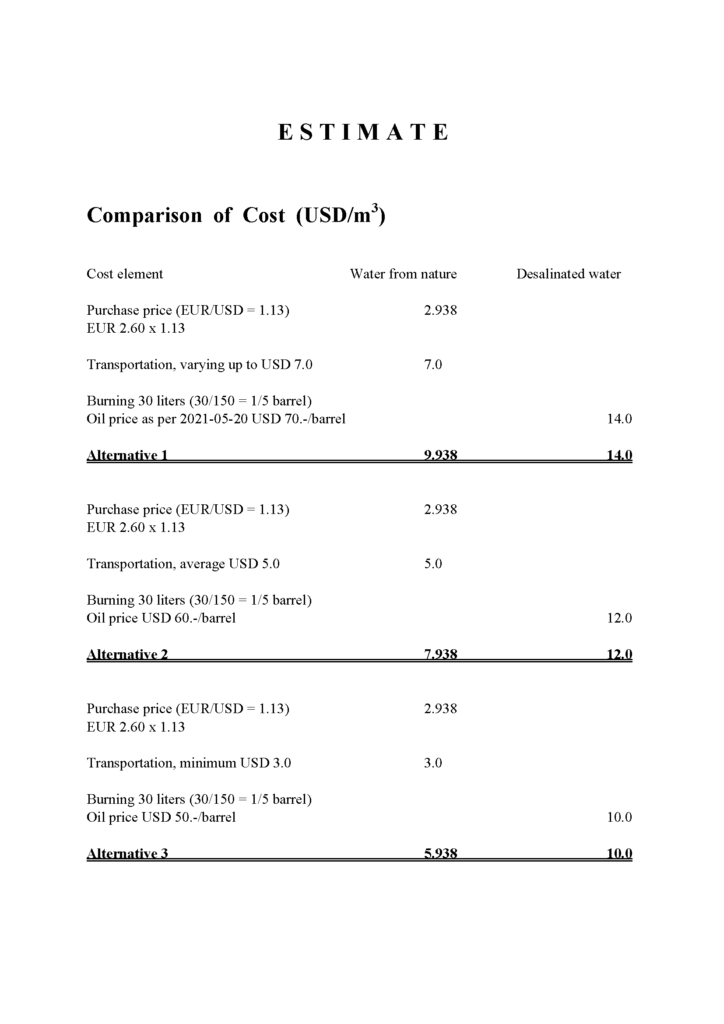
Fundemental basic facts
The Middle East is one of the poorest areas in the world in terms of sweet water, and the countries in the region compensate for it by the use of desalinated water. Some 65% of the global desalination capacity is located in the Arabian Peninsula, and a majority of the plants are distillation plants.
The desalination process is costly in terms of energy consumption, which in turn results in unwanted emissions to the environment, locally to the sea, and globally to the air.
INOC-INBA Report
Click here to see the report (opens in new tab) from the INOC-INBA international workshop on desalination and marine pollution
Local emissions to the sea
The most easily seen emission is the remaining salt that is flushed back to the sea shore outside the desalination plant. When producing 100 mill. tons of desalinated water, 4 mill tons of salt is going back to the sea shore, based on 4% salt concentration in the sea water.
In addition, different chemicals are flushed back to the sea, also those added to the process on purpose. This was highlighted in a report on “Environmental Aspects of Desalination” presented to a workshop in Dubai already in December 2003, excerpt attached. The report is also pointing at an increase of temperature up to 5-6 °C in the Arabian Gulf, all together killing any life in the coastal area of desalination plants.
Global emissions to the air
In this context the emission is CO2 from the burning of oil according to our pamphlet page 8.
In front of UN’s 26th Conference on Environment COP26 primo November in Glasgow, UN’s Leader of Environment, Patricia Espinosa, has expressed that one of the main questions is how to limit the global temperature increase to 1.5 °C. According to BBC’s reporting, the answer is split in two:
- 1. The emission of greenhouse gases have to be “Net zero“ within 2050, meaning removal of the same quantity CO2 from the athmosphere as totally emitted. Suggested is the use of technology for carbon-capture-and-storage.
- 2. Some specific countries have to cut their CO2 emissions substantially.
Also the court systems around the world are about to be aware of the damage from the CO2 emissions, and The Hague District Court did order Royal Dutch Shell to cut emissions more than planned until 2030.
Our contribution
There is abundant sweet water on the globe. The challenge is, however, that the location of the sweet water sources and the areas where people are living, are not always the same. This fact calls for the transportation of sweet water, and that is where the The Water Transportation Project LLC
come into the picture. Our basic idea is to replace part of the desalinated water by shiploads of sweet water to be unloaded straight into tanks and pipelines of local distribution nets, wherever they are available together with a deepwater quay. Based on previous experiments and operations we have the knowledge and experience to take care of such activities.
Also, we have the know how and contacts to assist in locating suitable second hand tankers, which for obvious reasons should be of Suezmax size, and we will make recommendations with regard to cleaning and rebuild of the tankers for safe sweet water transportation.
Attached is a map of the Middle East and the Mediterranean Sea where we have colour marked what we see as potential unloading areas for the ships loads. Also we have pointed out positions where we have access to sweet water, or we are in negotiations to obtain access.

Sweet Water Transportation VS Desalination
Desalination of sea water has for a long time been a commonly used method for the procurement of sweet water to communities in arid areas. There are two different methods used for desalination, i.e. distillation and reverse osmosis, both of which extremely energy consuming. We have been looking into the distillation process, which is the oldest and most commonly used process, for which there are also reliable data and empirical formulas available. Our page Water transportation projects, under environmental impact lists the input data needed and the method of calculation of the impact on the global environment from the distillation process in the form of CO2 emissions to the air. It shows that, the evaporation of 100 mill. tons of sea water causes emissions of approx 19,2 mill. tons of CO2 to the air. it alsp shows the impact on the local environment in the form of concentrated salt returned to the sea water together with the process chemicals is listed. Also the temperature increase of the sea water caused by the process cooling water returned is mentioned, The impact on the economy is described on top of page 10-1 in the same brochure, and a comparison of cost/m3 sweet water from nature and desalination is made on the following page here. With regard to desalination, the cost of oil to be burned is the only cost calculated. Omitted are operational cost like manning, chemicals, spare parts, maintenance, and interest and depreciation of investment. Even then the best alternative for desalinated water barely matches the most expensive alternative for shipping of water from nature. The comparison also shows that, customers with good knowledge and contacts to the shipping business can save a lot of money by handling the transportation themselves, i.e. purchase water from nature FOB place of delivery. Finally, there is a substantial difference in quality between desalinated water and water from nature.
Advantages for countries reducing desalination
It is expected that countries deciding to reduce the level of desalination will improve their future reputation substantially, since some 20 years have already gone by, and upon further possible 20 years lost, the above mentioned dead line 2050 will be too close. There is also an economic side, where the countries will gain financially since oil is a costly resource to burn along with other costs like plants investment, maintenance and other costs. We have made an estimate, that show even the most costly transportation is cheaper than desalination.

